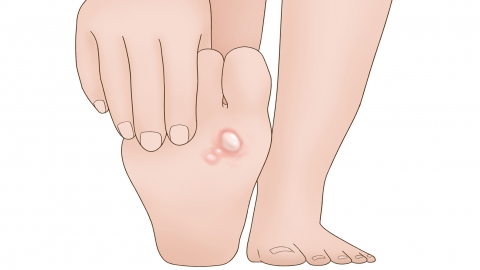What causes the soles of the feet to become itchier when scratched?
Generally, increased itching on the soles of the feet when scratched is often related to factors such as dry skin, contact dermatitis, dyshidrotic eczema, athlete's foot (tinea pedis), or eczema. Scratching can worsen skin damage and should be addressed with targeted treatments. If itching persists or is accompanied by peeling or blisters, it is advisable to monitor skin changes closely. Detailed explanations are as follows:

1. Dry Skin
In autumn and winter or after frequent foot washing without moisturizing, moisture loss from the skin on the soles leads to dryness and cracking of the stratum corneum. Scratching stimulates nerve endings, intensifying itchiness. Apply petroleum jelly or urea-vitamin E cream promptly after washing feet to maintain skin hydration. Avoid using strongly alkaline soaps and excessive cleaning that may disrupt the skin’s natural oil layer.
2. Contact Dermatitis
Itching may occur when the soles come into contact with poor-quality socks, shoe materials, or chemical substances in insoles, triggering an allergic reaction. Scratching can exacerbate redness and itching. Immediately replace suspected irritants and wash the feet with lukewarm water. For significant itching, use mometasone furoate cream, loratadine tablets, or cetirizine hydrochloride tablets under medical guidance to relieve allergic symptoms.
3. Dyshidrotic Eczema (Sweat Blisters)
Excessive sweat gland activity in the soles combined with blocked sweat discharge can lead to small blisters accompanied by itching. Scratching may cause blister rupture and infection, worsening discomfort. Keep feet well-ventilated and avoid hot, humid environments. Under medical supervision, use calamine lotion or triamcinolone acetonide urea cream to reduce blisters and itching, and avoid scratching to prevent infection.
4. Athlete’s Foot (Tinea Pedis)
Fungal infection of the sole skin causes itching. Scratching damages the skin barrier, promoting fungal spread and worsening itch. Avoid scratching, keep feet dry, change socks frequently, and wear breathable shoes. Under medical guidance, apply terbinafine hydrochloride cream, miconazole nitrate cream, or bifonazole cream according to prescribed treatment duration to suppress fungal growth.
5. Eczema
Eczema on the soles can be triggered by moisture, friction, or other irritants, presenting as red patches and itching. Scratching compromises skin integrity, leading to recurrent symptoms. Avoid damp environments and wear loose, breathable footwear. Under medical advice, use desonide cream, hydrocortisone butyrate cream, or chlorpheniramine maleate tablets to reduce inflammation and itching.
In daily life, maintain good foot hygiene—wash regularly but avoid over-cleaning. Choose cotton, breathable socks and shoes to minimize skin irritation. Avoid scratching when itching occurs; instead, apply cold compresses for temporary relief. If symptoms persist for more than one week, seek evaluation from a dermatologist to identify the underlying cause and receive appropriate treatment.




